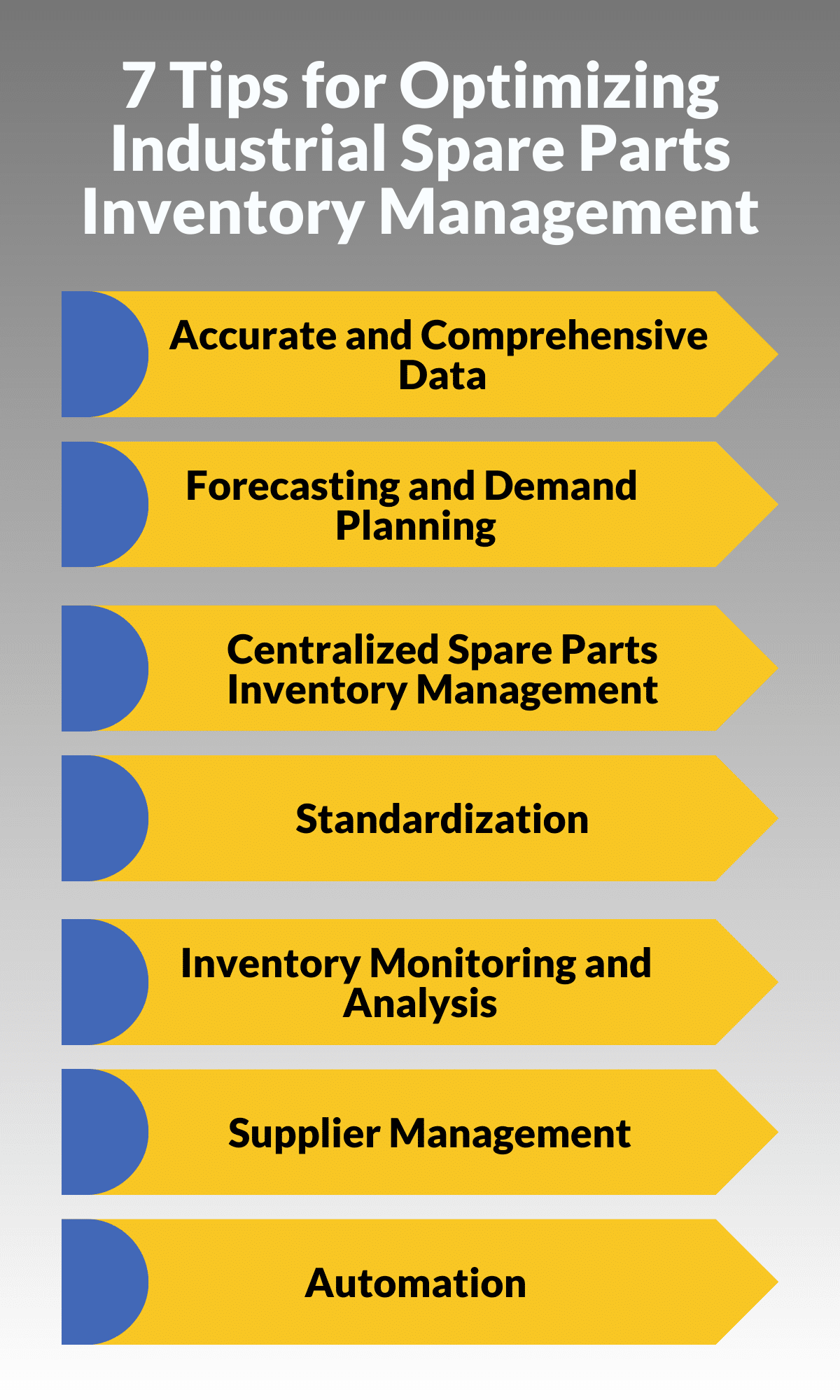Spare Parts Inventory Management can be a challenging task for manufacturers and distributors alike, it requires an adequate amount of investment in time and effort. Industrials must have the right parts available when needed while minimizing excess inventory. Failure to do so can result in stockouts, increased carrying costs, and dissatisfied customers. Fortunately, by implementing effective strategies and practices, Industrials can optimize their Industrial spare parts inventory management and ensure smooth operations.
7 Best Practices for Optimizing Industrial Spare Parts Inventory Management
Here are seven tips that can help you optimize your inventory management and get the most value out of it:

1. Accurate and Comprehensive Data
Data is a fuel that propels businesses and assists them in making informed decisions. As a result, reliable and complete data is required for optimizing spare parts inventory management. In other words, accurate and complete data is critical in inventory management.
Industrials should focus on the following things to get accurate and comprehensive data:
- Data should contain part numbers, lead time, descriptions, and supplier information.
- Inventory management software can assist in the accuracy of data.
- Inventory can also be tracked and managed using inventory management software.
- Inventory management software can provide predictive insights into future inventory issues.
2. Forecasting and Demand Planning
For industrials, forecasting and demand planning play a critical role in ensuring optimal inventory. By leveraging historical data and predictive analysis, Industrials can predict future demand and plan inventory levels accordingly.
To obtain accurate forecasting and demand planning, Industrials must consider various factors:
- Seasonality – Seasonality refers to the regular fluctuations in demand that occur throughout the year. By analyzing historical data and taking into account seasonal patterns, Industrials can plan for inventory levels that align with predicted demand.
- Trends- Trends refer to changes in consumer behavior over time. By identifying and analyzing trends, Industrials can adjust their inventory levels to meet changing demands and capitalize on emerging opportunities.
- New product launches – New product launches can have a significant impact on demand and inventory levels. By closely monitoring product launches and adjusting inventory levels accordingly, Industrials can maximize sales and minimize waste.
3. Centralized Spare Parts Inventory Management
Inventory management centralized over many sites may give substantial benefits to industrial enterprises. Companies may optimize inventory levels by integrating inventory data into a centralized system.
Benefits of Centralized Spare Parts Inventory Management:
- Companies can benefit from centralized spare parts inventory management by reducing surplus inventory and eliminating repeat orders.
- Another advantage of centralizing spare parts inventory management is improved visibility throughout the organization.
- To attain these benefits, dependable inventory management software with powerful analytics and machine learning capabilities is required.
- Businesses may optimize inventory levels and boost profitability by making data-driven choices.
4. Standardization of Spare Parts Inventory Management
In the industrial sector, standardizing parts is a critical strategy to optimize the supply chain and enhance efficiency. By minimizing the number of unique SKUs in inventory, Industrials can reduce complexity, minimize costs, and streamline procurement operations.
Standardizing to optimize spare parts inventory management:
- Standardizing parts enables industrials to centralize their purchasing, negotiate better pricing with suppliers, and better manage stock levels.
- By standardizing parts, industrials can reduce the risk of inventory obsolescence and improve cash flow by reducing the amount of capital tied up in inventory.
- Standardization helps to ensure consistency and quality across products, which is critical for meeting customer demands and maintaining brand reputation.
- Leveraging standardization can increase the agility, responsiveness, and competitiveness of industrials in today’s rapidly evolving market.
5. Inventory Monitoring and Analysis
Industrials must use dependable inventory management software to optimize inventory management, expedite activities, and cut inventory holding costs. It offers vital information and insights to assist organizations in making educated decisions and maintaining appropriate inventory levels.
Optimizing Inventory Management with Reliable Inventory Management Software:
- Continuous inventory data monitoring and analysis is required for organizations to maintain appropriate inventory levels.
- Reliable inventory management software can help businesses streamline tasks and ensure critical parts are always in stock while minimizing carrying costs.
- Advanced features like real-time inventory tracking, demand forecasting, and automated replenishment can help businesses reduce stockouts, improve inventory turns, and minimize excess inventory.
- Inventory management software empowers businesses to make data-driven decisions, enhance operational efficiency, and drive profitability.
6. Supplier Management
Developing excellent supplier connections may help firms improve lead times, quality, and cost. Vendor-managed inventory (VMI) programs can boost these benefits even further by lowering inventory carrying costs and assuring timely delivery. VMI enables suppliers to take on greater responsibility for inventory control, allowing enterprises to focus on core activities.
Optimizing Inventory Management with supplier management:
- Suppliers may use VMI programs to control inventory levels, track consumption, and refill items as needed, lowering inventory carrying costs and assuring timely delivery.
- Businesses may concentrate on core activities while suppliers control inventory levels, resulting in greater operational efficiency.
- VMI helps improve inventory accuracy, reduce stockouts, and lower carrying costs, benefiting businesses by optimizing inventory management.
- Collaborative relationships fostered through VMI can lead to better quality, pricing, and lead times, ultimately strengthening the supply chain operations.
7. Automation
Automation has become an essential component of inventory management for firms seeking to increase productivity and eliminate mistakes. Industrials may optimize their inventory management procedures by adopting automated solutions such as Inventory Management software, freeing up valuable resources to focus on strategic goals.
Benefits of leveraging automation with Inventory Management Solutions:
- Automated inventory management tools such as demand forecasting and real-time inventory tracking can help businesses optimize their inventory levels and reduce carrying costs.
- Inventory Management Software can automate routine tasks, reducing the risk of human error and improving operational efficiency.
- Real-time visibility into inventory levels across all locations provided by Inventory Management software can help businesses make data-driven decisions and optimize their supply chain operations.
- By automating inventory management processes, businesses can reduce costs and drive profitability.
Read about 3 AI trends Industrial OEMs should watch out for in 2023 and beyond
Optimizing industrial spare parts inventory management is a vital facet of running a successful organization. Industrials may decrease expenses and enhance efficiency by adhering to best practices. The Inventory Management system is intended to assist organizations in streamlining their procedures. With extensive capabilities such as demand forecasting, real-time inventory tracking, and automatic replenishment, our software can assist firms in optimizing inventory levels and lowering carrying costs. Industrials may enhance operational efficiency and eventually profitability by implementing our solution.








